French researchers developed an adhesive material made from a hydrogel filled with nanoparticles, that could prevent wound dressings from falling off in contact with water or when you sweat, or even deliver drugs through the skin.
In contact with water, most patches lose their ability to stick to the skin and fall off, but this problem could soon be over thanks to a team of scientists led by Bruno Grassl from the University of Pau and Pays de l'Adour.
They have developed adhesive materials based on hydrogels that will turn this problem into a thing of the past, RSC reports.
The specificity of hydrogels is that they already contain a considerable amount of water, and this allows them to tolerate additional water from sweat.
Their flaw, however, is poor elasticity, so the researchers needed to improve the mechanical properties and induce pressure-sensitive adhesiveness, so that the patch would stick when pressure is applied.
To do so, they filled hydrogels with nanoparticles made from polystyrene, and this made them better adhesives and rose their mechanical properties.
During their research, the scientists found that a hydrogel component made from polyacrylamide and poly(acrylamide-hydroxyethyl methacrylate) had the best adhesion and mechanical strength.
After testing the material on artificial skin – made from fat components and protein, they saw that the material was easy to remove from the skin, which is very important for skin contact applications.
Christophe Derail who worked on the project, explained that “there is a link between the gels' rheological [flow] properties and their adhesive properties.
“Nanoparticles can keep the rheological behavior constant even if the gel absorbs a large amount of fluid.”
As said before, the hydrogels' ability to retain water could make them perfect for containing fluid excipients (carriers that enhance drug transport), thus making them act as dressings or skin patches for drug delivery.
Jian Ping Gong, an expert on the properties and applications of gels at Hokkaido University, Japan, considers this to be a very interesting piece of research.
She says that “the application of a hydrogel as a pressure-sensitive adhesive has many advantages over conventional adhesives owing to the hydrogel's permeable nature,” and adds that since the copolymer from acrylamide and hydroxyethyl methacrylate is inert to cells, this makes it suitable for skin contact materials.
This research was published in Soft Matter, a journal of the Royal Society of Chemistry.

 14 DAY TRIAL //
14 DAY TRIAL //